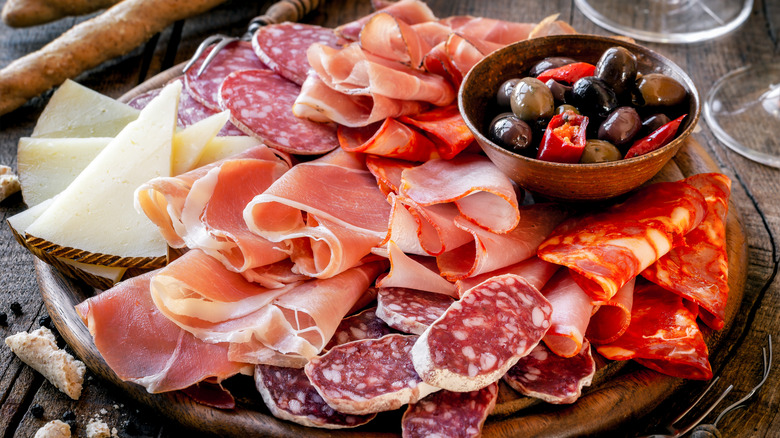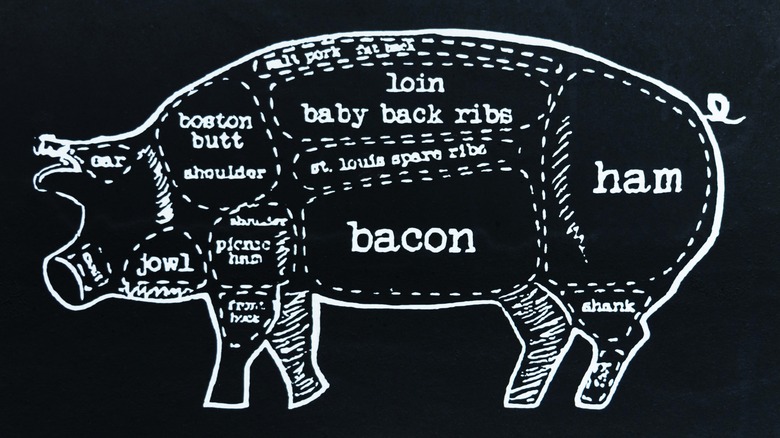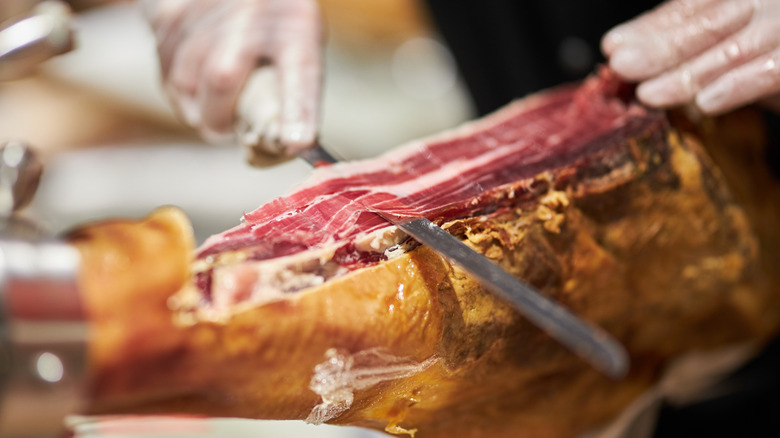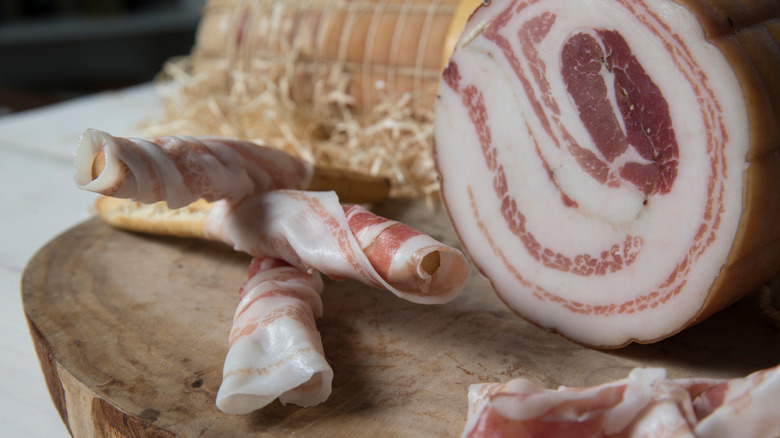What's The Difference Between Pancetta And Prosciutto?
The key to an excellent charcuterie board is variety; the wider the spread, the more bountiful your board will look. Though we associate it with a collection of cheese, spreads, crackers, and salami, the actual word charcuterie refers explicitly to the art of preparing and presenting meats (via The Washington Post). Therefore, the best way to beef up your charcuterie is with an extensive selection of protein. Ironically, charcuterie is a French word that generally refers to an entire culinary branch of meat preparation, but Italian delicacies like salami, mortadella, and capicola have come to rule the boards.
The Italian restaurant Bottiglia (which specializes in Tuscan-style antipasto) explains that meats we recognize as essential charcuterie cast members, in fact, originate in the tradition of Italian cuisine called salumi which uses salting or curing to prepare and preserve meats (primarily pork). However, not all salumi is the same, and creating optimal pairings of meats, cheeses, and accouterements requires a little background knowledge of your ingredients. Though many cured meats are pretty discernable from each other, a couple of the more commonly conflated cuts are prosciutto and pancetta. When it comes to putting together an A-plus charcuterie platter (or affettati misti), it's imperative to know the difference between prosciutto and pancetta.
From the butcher's block
Primarily, the difference between prosciutto and pancetta comes down to the cut of meat. Though both are Italian, and both are cured meats, pancetta is made from pork belly while prosciutto, on the other hand, comes from the cut of the leg also called the ham, notes Food Network. Though it may seem minute, the variation between ham and pork belly makes all the difference.
In matters of meat, the type of cut is important because of the dynamic role of fat. Samin Nosrat explains in her book "Salt Fat Acid Heat" that on a molecular level, the water in muscle tissue repels a majority of the essential flavors and aromatics of meat. Fat, however, bonds with those flavor molecules and retains more of the distinct qualities of the animal.
If we look at just the cuts alone, pork belly has a much higher fat-to-muscle ratio compared to ham. As a result, pork belly retains more of that essential "porkiness," which is why it's commonly used, as Food Network suggests, to flavor other dishes (such as carbonara). Because both pancetta and bacon come from pork belly, for example, they are more easily interchangeable with each other than with prosciutto, which is prized more for its tenderness than for its fat content. While you can technically swap it in for pancetta, it is a fundamentally different ingredient.
The prosciutto curing process
One of the reasons prosciutto and pancetta get mixed up is that they are both salt-cured in a similar way. Curing is a way of preserving meat for extended periods of time by using salt, acids, or smoke to make the surface inhospitable to microorganisms that would otherwise cause the meat to go rancid, explains the National Center for Home Food Preservation. The process of curing prosciutto is simple enough, but also time-intensive and environment-specific.
According to Eataly, prosciutto starts with "high-quality pork legs ... covered in salt and left to rest for a few weeks." After this first round, the legs are washed and seasoned, then "left to dry-age at a controlled temperature for 14 to 36 months." The National Center for Home Food Preservation explains that the pork legs don't go bad during this time because the salt works to draw out excess moisture from the meat, thereby inhibiting the growth of microbes in a process called plasmolysis. MasterClass adds that different regions of Italy also have distinct legal regulations for prosciutto, bolstering the reputation of its producers as well as the authenticity of the overall market.
Pancetta curing results in a vastly different product from prosciutto
Pancetta, on the other hand, is a cut of pork belly that is cured in a similar way, but because of the greater fat content, it takes significantly less time to draw out the water from the muscle. According to Food Network, the pork belly is seasoned with spices during the salt cure to compliment the flavors within the fat. It's then tightly rolled into a log, encased with butcher's twine, and left to dry-age for anywhere between four weeks and three months, details Cook Gem.
The varying curing methods and starting cuts yield drastically different end products. Prosciutto is ruddy in color, with marbled fat and a salty, buttery flavor profile, as MasterClass describes. Pancetta comes out with a bit more of a robust flavor (on account of the fat and spices) and much more pork fat, with a lighter pink coloration. Ultimately, if you're trying to choose between pancetta or prosciutto to feature on a charcuterie board, prosciutto is a more nuanced flavor that would be appreciated with cheese and crackers, while pancetta would shine brighter accenting a dish that could use a little extra fatty richness.



